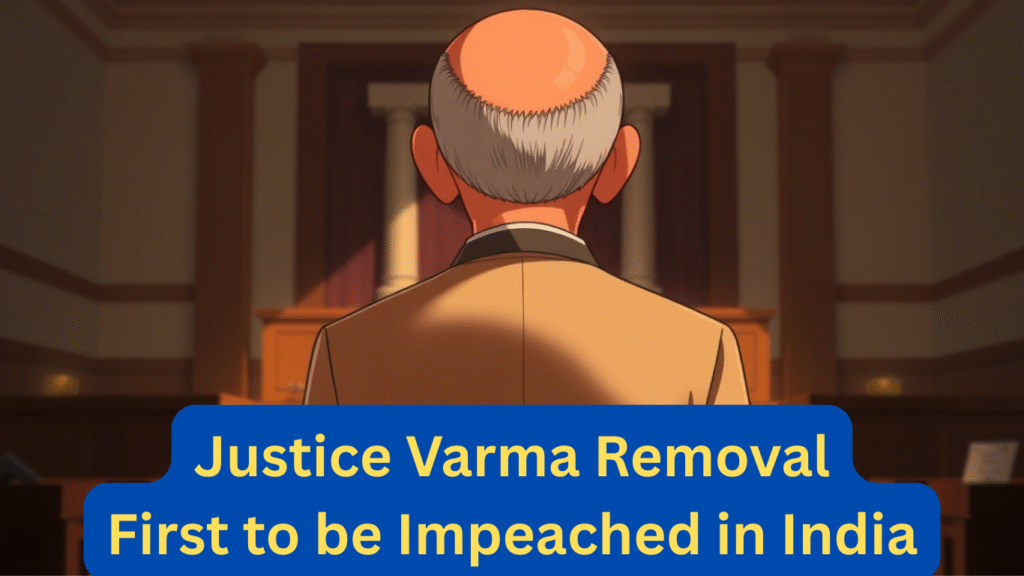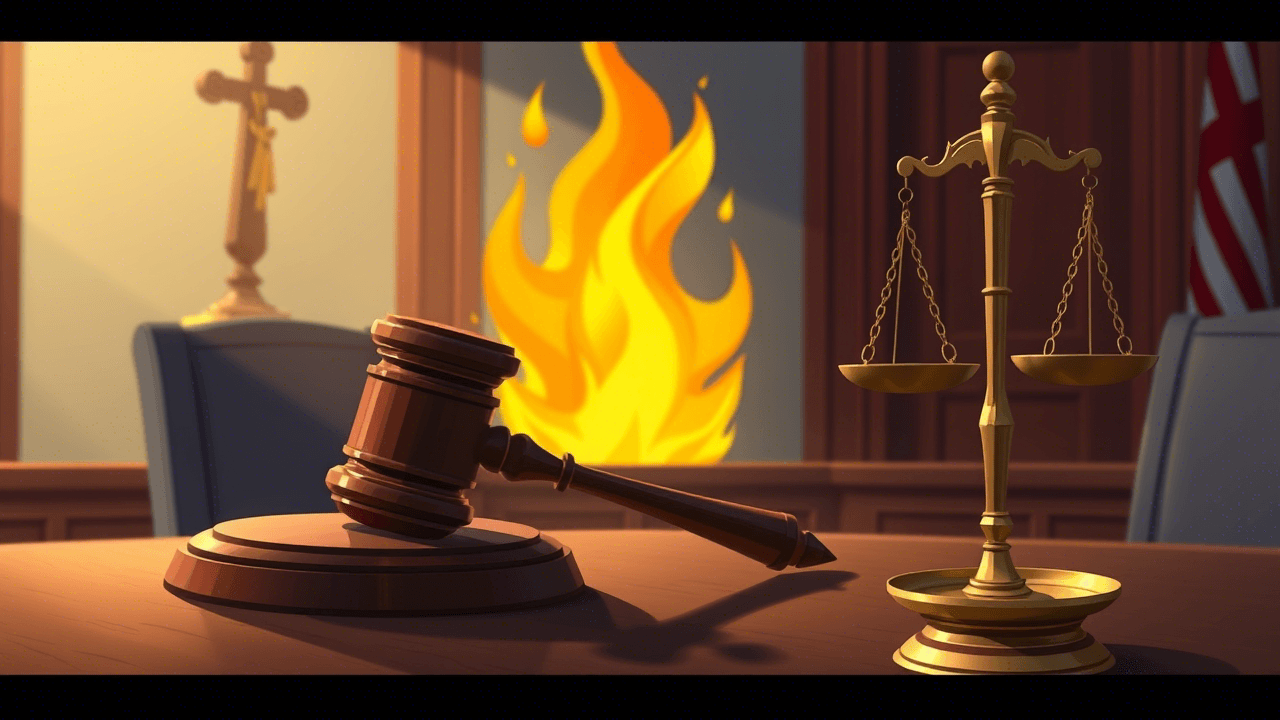
A senior judge of the Allahabad High Court, Justice Yashwant Varma, is facing removal from his position after a large amount of unexplained cash was found during a fire at his home.
The incident happened on March 14 , when there was a fire at Justice Varma’s official residence in New Delhi. At that time, he was working at the Delhi High Court . During the fire, officials found a large amount of money in a storeroom at his house. This led to an investigation into the matter.
Table of Contents
Inquiry Committee Report

To look into the case, a three-member inquiry committee was formed by the Chief Justice of India (CJI), Sanjiv Khanna . The committee included:
- Chief Justice Sheel Nagu of Punjab and Haryana High Court
- Chief Justice GS Sandhawalia of Himachal Pradesh High Court
- Justice Anu Sivaraman of Karnataka High Court
After studying all the evidence and taking statements from over 50 people — including top police and fire officers — the committee submitted its report on May 3 . It clearly stated that a large stash of cash was found during the fire at Justice Varma’s house.
Justice Varma was given a chance to explain himself. He replied on May 6 , but the CJI was not satisfied with his explanation.
For the latest current affairs and articles covering national, international, and trending topics, please click here.
CJI Recommends Removal
Since Justice Varma did not step down as advised by the CJI Sanjeev Khanna, the Chief Justice of India recommended his removal to the President of India and the Prime Minister. According to the Indian Constitution, judges can be removed if they are found guilty of misconduct.
On March 28 , Justice Varma was transferred from the Delhi High Court to the Allahabad High Court , his parent court. However, he has not been given any work there for now.
This is one of the rare cases where a sitting judge is being considered for removal based on an internal inquiry by the Supreme Court, also known as the in-house procedure .
First CJI: Justice Harilal J. Kania was the first Chief Justice of India, serving from 1950 until his death in 1951.
52nd CJI: Bhushan Ramkrishna Gavai will be the 52nd Chief Justice of India, will sworn in on May 14, 2025.
Process of Removing a Judge Under the Indian Constitution
In India, judges of the Supreme Court and High Courts hold their positions with high responsibility and integrity. The Constitution ensures that they can only be removed through a special process and not by any ordinary legal or administrative action. This provision guarantees judicial independence while also ensuring accountability .
Constitutional Provisions
The removal of judges is governed by the following constitutional articles:
- Article 124(4) – For the removal of Supreme Court judges
- Article 217(1)(b) – For the removal of High Court judges
A judge can be removed only on grounds of proven misbehavior or incapacity . It is a rare and serious step, and the process is designed to be thorough and fair.
Steps Involved in the Removal Process
- Motion for Removal :
A motion for the removal of a judge can be introduced in either House of Parliament (Lok Sabha or Rajya Sabha). - Minimum Support Required :
The motion must be supported by at least 100 members of Lok Sabha or 50 members of Rajya Sabha before it is admitted. - Investigation Committee :
Once the motion is admitted, an independent committee is formed to investigate the charges. The committee usually consists of:- A Chief Justice or Judge of the Supreme Court
- A Chief Justice of a High Court
- An eminent jurist nominated by the President
- Parliamentary Approval :
After the investigation confirms the charges, the report is presented to Parliament. The motion for removal must then be passed by a special majority in both Houses:- A majority of the total membership of the House
- At least two-thirds of the members present and voting
- Removal by President :
Once passed by Parliament, the final order of removal is made by the President of India .
Key Points to Remember for Exams
- The process of removal is initiated in Parliament , not by the judiciary.
- Judges cannot be removed for political reasons or personal vendettas .
- The in-house procedure is used for internal complaints within the judiciary before any parliamentary action.
- No judge has been removed so far in India through this process, though some cases have reached advanced stages.
To explore the rich history and diverse cultural heritage of Punjab (History & Culture), please click here.
Historical Cases Related to Removal of Judges in India
Although the Indian Constitution provides a procedure for the removal of judges , no judge of the Supreme Court or High Court has ever been successfully removed from office so far . However, there have been a few notable cases where impeachment or removal proceedings were initiated , highlighting concerns about judicial accountability and independence.
Justice V. Ramaswami (1991–1993)
The first-ever attempt at impeaching a Supreme Court judge was against Justice Veeraswami Ramaswami in 1991. He was accused of misappropriation of funds and financial misconduct during his tenure as a judge in the Punjab and Haryana High Court.
- A motion for his removal was introduced in the Lok Sabha .
- The investigation committee found him guilty.
- However, the motion failed to pass in Parliament because it did not receive the required two-thirds majority in the Lok Sabha.
- This case highlighted the difficulty of removing a judge , even when charges are proven.
Justice P.D. Dinakaran (2010)
Justice P.D. Dinakaran, a former Chief Justice of the Sikkim High Court, faced allegations of corruption , land grabbing , and maintaining assets disproportionate to his income .
- An inquiry committee under the National Judicial Accountability Commission Act (NJAC) found prima facie evidence of misconduct.
- He resigned before any formal action could be taken , thus avoiding impeachment.
Justice Soumitra Sen (2011)
Justice Soumitra Sen of the Calcutta High Court was the only judge against whom impeachment proceedings were successfully passed by the Rajya Sabha .
- He was accused of misappropriating public funds during his time as a judge.
- The impeachment motion was passed by the Rajya Sabha , but before the Lok Sabha could vote , he resigned in 2011.
Justice Gogoi Impeachment Motion (2018)
In 2018, a group of 22 opposition MPs moved an impeachment motion against then Chief Justice of India Dipak Misra , which later included Justice K.M. Joseph Gogoi .
- The motion was based on allegations of misuse of official position and personal vendetta .
- It was not supported by the majority in Parliament and eventually lapsed.
- This case raised debates about the transparency and accountability of the judiciary.
Key Takeaways for Competitive Exams:
- No judge has been successfully removed from the Supreme Court or High Court till date.
- The first impeachment motion was against Justice V. Ramaswami in 1991.
- Justice Soumitra Sen is the only judge whose impeachment was passed by one House (Rajya Sabha).
- All other cases either lapsed , ended in resignations , or did not reach the final stage.
- These cases show that while the procedure exists , it is rarely used and difficult to complete due to high constitutional thresholds.
To learn more about English grammar and improve your language skills, please click here.
What Happens Next?
Now, it is up to the President of India , with advice from the government, to decide whether Justice Varma will be removed from his post.
This case shows how seriously the judiciary takes matters of trust and honesty, especially among judges who are expected to follow high moral standards.
To enhance your English vocabulary with helpful articles, word lists, and practice exercises, please click here.
Static GK related Judges of Supreme Court and High Court
1. Supreme Court of India – Key Facts
| Point | Details |
|---|---|
| Established | 28 January 1950 |
| Total Number of Judges (incl. CJI) | 34 (as per Article 124) |
| Current Chief Justice of India (CJI) | Sanjiv Khanna |
| First Chief Justice of India | H. J. Kania (1950) |
| Tenure of CJI | Until the age of 65 |
| Appointment Authority | President of India |
| Retirement Age | 65 years |
| Appointed Under | Article 124 of the Constitution |
| Removal Process | Impeachment by Parliament (special majority) |
2. High Courts in India – Key Facts
| Point | Details |
|---|---|
| Total Number of High Courts | 25 |
| First High Court in India | Calcutta High Court (1862) |
| Highest Number of Judges (HC) | Allahabad High Court |
| Lowest Number of Judges (HC) | Sikkim High Court |
| Tenure of High Court Judges | Until the age of 62 |
| Appointment Authority | President of India (in consultation with others) |
| Appointed Under | Article 217 of the Constitution |
| Retirement Age | 62 years |
| Jurisdiction | State(s) and Union Territories |
| Can a HC Judge become SC Judge? | Yes, eligible for elevation |
3. Difference Between Supreme Court and High Court Judges
| Criteria | Supreme Court | High Court |
|---|---|---|
| Retirement Age | 65 years | 62 years |
| Appointment | By the President | By the President |
| Article of Constitution | Article 124 | Article 217 |
| Minimum Age | No minimum mentioned | No minimum mentioned |
| Jurisdiction | Entire country | Specific state or UT |
| Removal | By impeachment (Parliament) | By impeachment (Parliament) |
4. Qualification to Become a Judge
| Position | Minimum Qualification |
|---|---|
| Supreme Court Judge | – Citizen of India – Judge of HC for 5 yrs OR advocate in HC for 10 yrs |
| High Court Judge | – Citizen of India – Advocate in HC for 10 yrs OR judicial officer for 10 yrs |
5. Interesting Static GK Facts About Judiciary
| Fact | Detail |
|---|---|
| Youngest CJI of India | Justice H. J. Kania |
| First Woman Judge of Supreme Court | Justice M. Fathima Beevi (1989) |
| First Woman Chief Justice of a High Court | Justice Leila Seth (Himachal Pradesh, 1991) |
| Article for SC Establishment | Article 124 |
| Article for HC Establishment | Article 214 |
